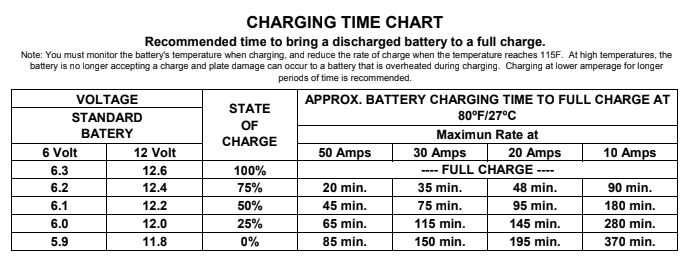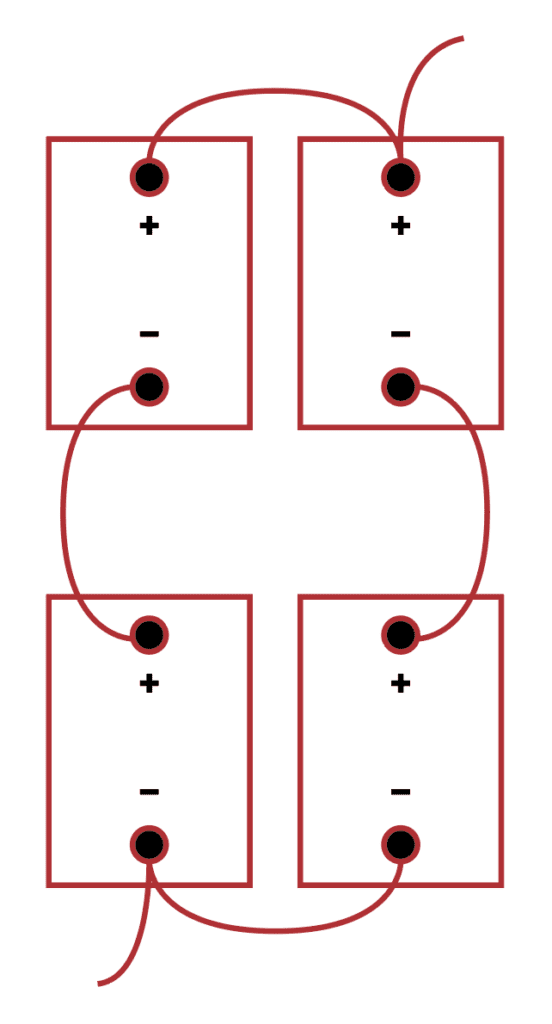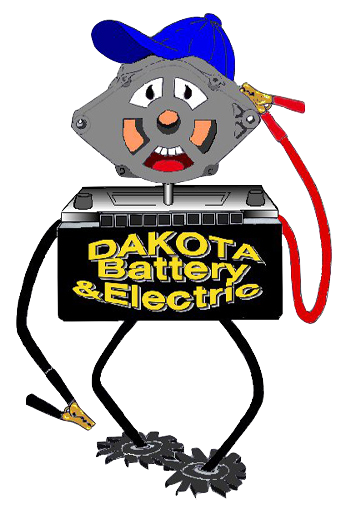Car Battery FAQ
- Keep your battery clean.
- Keep your terminals clean.
- Maintain proper fluid levels.
- Keep your battery charged.
- Maintain your battery during all seasons: bring it indoors and purchase a battery maintainer (call now to see if we have them in stock!)
Trojan Battery Company has manufactured batteries for eighty years. Our experience shows that the key to achieving optimum performance and long life is a solid battery maintenance program using the simple procedures outlined here.
Trojan recommends the following equipment for use in battery care and maintenance:
Wrench
Distilled water
Voltmeter
Hydrometer
Post cleaner
Baking soda
Petroleum jelly
Goggles and gloves
CAUTION: Always wear protective clothing, gloves and goggles when handling batteries and electrolyte.
Examine the outside appearance of the battery.
Look for cracks in the container.
The top of the battery, posts, and connections should be free of dirt, fluids and corrosion. (If batteries are dirty, see Cleaning section.)
Replace any damaged batteries.
Any fluids on or around the battery may indicate that electrolyte is spilling, leaching or leaking out.
Leaking batteries must be replaced.
Check all battery cables and connections.
Look closely for loose or damaged parts
Replace any cable that is broken or frayed
WARNING: Do not smoke near batteries
Tighten all wiring connections to the proper specification. Be sure there is good contact with the terminals. WARNING: Do not over-tighten terminals. Over-tightening can result in post breakage, post meltdown or fire.
If any specific gravity reading still registers lower than the factory specification, one or more of these conditions may exist:
The battery is old and nearing end of life.
The battery was left discharged too long.
Electrolyte was lost due to spillage.
A week or bad cell is developing.
The battery was over-watered prior to testing.
Batteries in conditions 1-4 should be taken to a specialist for further evaluation or retired from service.
For accurate voltage readings, batteries must remain idle (no charging, no discharging) for at least 6 hours, and preferably 24 hours.
Disconnect all loads from the batteries.
Measure the voltage with a DC voltmeter.
Check the state of charge with the table below.
Charge the battery if it registers 0-70% charged.
If battery registers below table values, these conditions may exist:
The battery was left discharged too long.
The battery has a bad cell.
Batteries in these conditions should be taken to a specialist for further evaluation, or retired from service.
Water should only be added after fully charging, there should be enough water to cover the plates. If the battery. has been discharged (partially or fully), the water level should also be above the plates.
Important things to remember:
Do not allow plates to be exposed to air.
Do not fill the water all the way up to the cap.
Do not use water with a high mineral content.
Use only distilled or deionized water.
CAUTION: The electrolyte is a solution of acid and water, so skin contact should be avoided.
Procedure:
Remove the vent caps and check the electrolyte level; the minimum level is to the top of the plates.
If there is no electrolyte visible, add just enough water to cover the plates.
Replace and tighten all water vent caps.
Put batteries on a complete charge before adding any more water. (See Charging section.)
Once charging is completed, remove the vent caps and check the electrolyte level.
Add water until the electrolyte level is 1/8″ below the bottom of the fill well.
Clean, replace and tighten all vent caps.
WARNING: Never add acid to a battery.
Check that all vent caps are tight.
Clean the battery top with a cloth or brush and a solution of baking soda and water. Do not allow any cleaning solution or other foreign matter to get inside the battery.
Rinse with water and dry with a clean cloth.
Clean battery terminals and the inside of cable clamps with a post and clamp cleaner.
Reconnect the clamps to the terminals and thinly coat them with petroleum jelly.
Keep the area around batteries clean and dry.
Important things to avoid:
Freezing – Avoid locations where freezing temperatures are expected. Keeping batteries at a high state of charge also prevents freezing. (See table below)
Heat – Avoid direct exposure to heat sources, such as radiators or space heaters. Temperatures above 80º accelerate the battery’s self-discharge characteristics.
Procedure:
Completely charge the battery before storing.
Store the battery in a cool, dry location, protected from the elements.
During storage, monitor the specific gravity (flooded batteries) or voltage. Stored batteries should be given a boost charge when they show a 70% state of charge or less. (See table above)
Completely charge the battery before reactivating.
For optimum performance, equalize the batteries (flooded) before putting them back into service (See Equalizing section).
Correctly charging batteries requires administering the right amount of current at the right voltage. Most charging equipment automatically regulates these values. Some chargers allow the user to set these values. For proper charging, refer to the instructions that came with your charging equipment.
Important things to remember:
Become familiar with, and follow the instructions from, the charger manufacturer.
Batteries should be charged after each period of use.
Lead-acid batteries do not develop a memory and need not be fully discharged before recharging.
Charge only in well-ventilated areas. Keep sparks or flames away from a charging battery.
Verify charger voltage settings are correct.
Check electrolyte level. (See Watering section).
Tighten all vent caps before charging.
Do not overcharge or undercharge the batteries.
Never charge a frozen battery.
Avoid charging at temperatures above 120ºF.
WARNING: Do not equalize Gel or AGM batteries.
Equalizing is an overcharge performed on flooded lead-acid batteries after they have been fully charged. It helps eliminate stratification and sulfation, two conditions that can reduce the overall performance of a battery.
Trojan recommends equalizing only when low or wide ranging specific gravity (+/- .015) is detected after fully charging a battery.
Procedure:
Verify that batteries are the flooded type.
Remove all loads from the batteries.
Connect battery charger.
Set charger to equalizing mode.
Start charging batteries.
Batteries will begin gassing and bubbling vigorously.
Take specific gravity readings every hour.
Equalization is complete when specific gravity values no longer rise during the gassing stage.
NOTE: Many chargers do not have an equalization setting, so this procedure cannot be used.
Two or more batteries can easily connected to boost your systems voltage and/or capacity. There are three methods to obtain additional voltage and/or capacity, as described below:
To increase voltage, connect batteries in series.
Battery system: 12 volt, 225 AH using two T-105 deep cycle batteries (6 volts, 225 AH)
To increase amp-hour capacity, connect batteries in parallel.
Battery system: 6 volt, 450 AH using two T-105 deep cycle batteries (6 volts, 225 AH)
To increase both voltage and amp-hour capacity, connect batteries in series/parallel.
Battery system: 12 volt, 450 AH using four T-105 deep cycle batteries (6 volts, 225 AH)
NOTE: These systems can also be configured using 12-volt batteries. It is not recommended that you mix batteries of different voltages within the same system.
Active material – In the positive plates, t he active material is lead dioxide. In the negative, it’s metallic sponge lead. When a circuit is created, these materials react with sulfuric acid during charging and discharging.
Ampere (Amp) – A unit of measurement for the electron flow or current through a a circuit.
Ampere-hour (Amp. Hr., AH) – A unit of measure for a battery’s electrical storage capacity, calculated by multiplying the current in amperes by the time in hours. (Example: A battery which delivers 5 amps for 20 hours provides 5 amps x 20 hours = 100 AH of capacity.)
Capacity rating – The time in minutes that a new, fully charged battery will deliver 25 amperes or 75 amperes at 80ºF and maintain a terminal voltage equal to or greater than 1.75 volts per cell.
CA – Cranking Amps, 32°
CCA – Cold Cranking Amps, 0° (recommended)
Cell – The basic current-producing unit in a battery. It consists of a set of positive plates, negative plates, electrolyte, separators and casing. A cell’s nominal voltage is 2 volts. (Example: A 12-volt battery has 6 cells.)
Circuit – The path followed by a flow of electrons. A closed, or short, circuit is a complete path. An open circuit has a broken path.
Cycle – One discharge of a battery plus one recharge.
Depth of discharge (DOD) – The percentage of capacity actually removed from a battery compared to the total rated capacity.
Electrolyte – In a deep cycle battery, it is a dilute solution of sulfuric acid and water.
Equalization – An overcharge performed on flooded lead-acid batteries after they have been fully charged. This maintenance step helps eliminate stratification and sulfation.
Hydrometer – A tool used to measure the specific gravity of the electrolyte solution.
MCA – Marine Cranking Amps, 70°
Ohm (Ω) – A unit of measurement for electrical resistance within a circuit.
Open circuit voltage – The voltage of a battery when there is no load attached (not receiving or delivering energy). This measurement is best taken when the battery has been at rest for at least 6 hours.
Power inverter – An electronic device that converts direct current (DC) power from a battery into standard alternating current (AC) house power.
Primary battery – An energy storage device that can deliver energy but cannot be recharged. (i.e. disposable flashlight battery.)
RC – Reserve capacity, 25 amps of discharge (recommended)
Secondary battery – An energy storage device that can deliver energy and can be recharged. (i.e. automotive or deep cycle battery.)
Separator – A divider made of porous material that is placed between the positive and negative plates in a battery cell and allows current to flow through it, while preventing direct contact between the plates which would cause a short circuit.
Specific gravity (S.G.) – A measurement of the strength of battery electrolyte by comparing its density to that of pure water.
Stratification – A condition where the concentration of acid is greater at the bottom of the battery than the top.
Sulfation – The formation of lead sulfate on the positive and negative electrodes.
Volt (V) – A unit of measurement for electrical potential within a circuit.
Watt (W) – A unit of measurement for electrical power.
Watt hour (Wh) – A unit of measurement for electrical power for a certain period of time.

Ampacity is the ultimate safe current carrying capacity of the wire before damage occurs to the insulation. These are suggested ampacities. Refer to the National Electric Code or your local code for correct wire size usage.
For more information, please visit www.trojanbattery.com or call 800-423-6569 and speak to our Applications Engineers.

